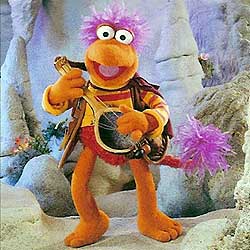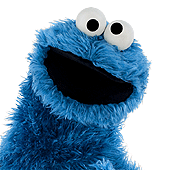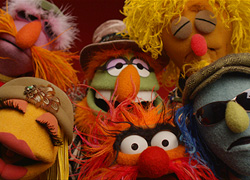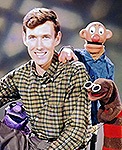Hey. Anybody remember this old thread?
I had some other assignments that I twisted into being Muppet-related over the year. But I have recently been urged to post my final paper.
The Assignment: Explore current research on a limited topic of personal choice. The final product will be an argumentative paper, using this research as evidence to support an original thesis and persuade a specific audience.
Teacher's suggestions: Use something you kind of know already; you've probably got an original thought about it already. It can be anything. For example, one girl wrote about how some words are innately funnier than others.
Here's what I turned in:
Puppet Personality
He stares out with thin, conspiring eyes of silver. His tan face is otherwise blank. “Come closer,” he says, sliding his words out. “I won’t bite…” But any levelheaded person would not trust him. There is no sympathy in his voice, no hint of gentility on his blank face. His slinky movements and sly voice add to the image of someone whose soul purpose is to scam away the rest of the world. His appearance is a clear definition of his personality. From nowhere, a hand appears and plucks the protruding silver slits right off of the face, leaving a harmless tan semi-circle. The scarcely visible mouth frowns, and the otherwise featureless face looks down. “I’m sorry,” he says quietly. Again, the hand appears. It takes hold of what would be the character’s nose and bottom jaw, and pulls. The tan skin comes slowly forward, revealing another hand. The first hand drops its spoils into the second. The girl holding these items looks at them, amused at the remnants of her makeshift puppet. Without a hand to shape it, the sly character is nothing more than two nylon foot stockings and two nickels.
Face and body shape have contributed to the characters of puppets throughout the history of puppetry. In Indian shadow puppetry, best preserved in Bali and Java, each puppet is given a simple character, defined by its appearance. With such simple personalities, they easily play out the religious messages that are so strongly connected to all Indian puppetry. A character with a downward-angled head is modest, and a character with a more upward-angled head is arrogant. (Baird, 59) The characters with admirable traits are slender with almond-shaped eyes and thin lips, and “their noses and foreheads run together in a straight line. The evil ones are broader and coarser and have round eyes” (58). The more comedic, clown-like characters, there to provide funny commentary on the play, are fat. (59) In 1667 England, the comedic Punchinello was a short fat marionette with a hump and hooked nose that were possibly inherited from a Roman clown. He was a part of the evolution of Punch, a more slapstick oriented hand puppet that inherited the hunched back and hooked nose, but became slimmer so it would be easier for him to hit and be hit by other characters. (97) In more recent times, the character Big Bird from
Sesame Street made the reverse change, at least in his head. In the first season of the show, Big Bird had very few feathers in his head, and he came across very dim-witted. Muppet designer Kermit Love added more feathers to Big Bird’s head for the second season, and he grew to be a wiser bird. (Borgenicht, 16) A few years later,
The Muppet Show would go through a similar transition with Fozzie Bear, a bad comedian with a big heart. He was originally built with an almost pear-shaped head, and in the first season he was seen as only a bad comedian. He was rebuilt to have a more well-rounded head, and in the second season he became a more well-rounded character. (Finch, 95) Putting more emphasis on a character’s slimness, Muppet designer and builder Don Sahlin gave
Sesame Street’s uptight character Bert a thin body with a tall, skinny, pointy head, and a vertically striped shirt. His all-vertical features are perfectly offset by his counterpart Ernie, also created by Don Sahlin. Ernie is a shorter, fatter character with a shorter, fatter head and horizontal stripes that make him more relaxed and laid back. (Borgenicht, 23)
Ernie’s red nose fits with European clown tradition, in which there are two kinds of clowns- “red nose,” the jokester, and “white face,” the straight man. Bert is certainly the straight man on
Sesame Street, and although he does not have a white face, Ernie the jokester is a perfect fit to his red nose. (
Tough Pigs, 58) In Balinese shadow puppetry, a white face denotes someone with a fiery nature. A black-faced character shows restraint, and a red-faced character has physical strength. The eyes are always cut last in the creation of a Balinese shadow puppet, because they are believed to give the character life. As mentioned earlier, the shape of the eye also denotes the character of the puppet. (Baird, 59) Muppet designers also tend to reveal certain characteristics through the eyes. Older characters typically have smaller pupils than younger characters. (Borgenicht, 169) For example, the Count von Count, written to have a psychological age of 1,832, 652 years, has smaller pupils than Elmo, written to have the psychological age of a three-year-old. (57, 84) And, although the details remain a company secret, Muppet designers also use a ratio called the “golden triangle” to determine the placement of the eyes in relation to the nose- or to where the eyes and nose would be, since they may or may not actually exist. (169) When it does exist, the nose may have its own details of the puppet’s character to reveal or emphasize. Wembley, a character on the international children’s show
Fraggle Rock, has an exceptionally long nose for a Fraggle. He also has difficulty making up his own mind, and he often goes along with what anyone around him suggests. His long nose makes it easy to see how the other characters physically and mentally push him around. (“Down at Fraggle Rock: Behind the Scenes”) On
The Muppet Show, a daredevil and performing artiste known as The Great Gonzo performs strange stunts such as eating a tire to the tune of “The Flight of the Bumblebee,” and he occasionally designs his stunts around the design of his blue hook-shaped nose, which is just as unusual as he is.
But The Great Gonzo was not always a successful character. Jim Henson originally built him without any particular character traits in mind, and gave him a gloomy expression with half-closed eyes. It was six years before the nameless puppet became The Great Gonzo and needed a personality. During the first year of
The Muppet Show, The Great Gonzo’s depressing character was as much of a failure as his acts were. But between seasons, his performer Dave Goelz rebuilt him with a mechanism that allowed him to open his eyes wide with excitement. Throughout the second season, Goelz was able to develop the happy side of Gonzo, who has since become a favorite of the Muppet characters. (Finch, 104)
Such eye mechanisms help to develop many characters, as they provide an essential ingredient in puppetry: movement. For example, the self-described “chronically groovy” bass guitar player Sgt. Floyd Pepper originally had mere sunglasses for eyes, but the sarcastic element of his character worked better when his shades were replaced with tube-like eyes that could blink, or remain closed while he laughed. But in some cases, such mechanisms actually inhibit the character. Fozzie Bear was originally built with a frowning mechanism, but it was removed when he was rebuilt because it added weight that made him difficult to handle and he did not need to frown to show that he was unhappy. He expresses his emotions through other movements, such as taking off his hat, playing with his scarf, or making other hand gestures. (
Muppet Central) Movement is part of what separates a puppet from a statue, and so it is essential in all forms of puppetry. The type of movement available to a specific puppet can determine a lot about the character.
Puppeteer Karen Prell says that, when she started performing on the television show
Fraggle Rock, she was not confident with her character of Red Fraggle until an episode in which Red tries to be another character, Mokey. The episode highlighted all of Red and Mokey’s differences, including their hair- Mokey, a calm, mature, and artistic character, wore her hair down, so that it was mostly stationary. Red, a spunky, energetic, competitive character, wore her hair in two large pigtails that seemed to bounce with her every move. (“New Interviews with Fraggle Rock Creators and Puppeteers”) The moving fabrics on puppets, such as hair or clothing, imply many things about the character, as well as what the character is doing. In India, the
Kathputli marionettes do not have any legs, but skirts or kilts that move as if there were legs underneath them. It is up to the imagination of the audience to visualize what the legs would be doing. (Baird, 51) Punch’s entire personality relies on his ability to grab and hold objects, swing them around, and hit people with them. This in part is why he became a hand puppet instead of a marionette.
If Punch had remained a marionette, he would not have been able to hit the other characters in Punch and Judy plays without getting tangled. He would have been a more subdued character, and thus less memorable. He either would not have been as loved by the audiences, or he would have developed a different character and been loved for different reasons. (96) When Kermit the Frog is excited, he waves his arms around in the air in a chaotic fashion that would not be possible if his arms were not on rods. (Finch, 21) On
Fraggle Rock, most of the Fraggles have arms on rods, like Kermit, but Mokey has “live” hands, meaning that her hands are like gloves that puppeteers put their hands in to manipulate. This allows her to paint, write, and play a clarinet-like instrument- actions that her personality mandates. (“Down at Fraggle Rock: Behind the Scenes”) The shadow puppetry employed in Bali is fairly restrictive of the more extreme motions of each character, but this keeps the puppets close to the religious purposes they serve. (Baird, 55)
All puppets are at least partially restricted. “Puppets can do about ten percent of what we ask them to do, and the rest has to be finessed and cheated” (“New Interviews with Fraggle Rock Creators and Puppeteers). They are a simplification of life, and it is from that simplification that they become true. (Baird, 15) Many people make a point of teaching themselves and their children that human beings should be judged by the content of their character, and not their appearance. But in puppetry, a simplification of life, appearance and character are intertwined. It adds a certain believability to a puppet if its appearance and character correspond, and that in a sense is the goal of puppetry- to imitate life in a believable fashion. A puppet is not made real by whether it is a hand puppet, sock puppet, or marionette. It is not the number of strings, mechanisms, or remote controlled devices it has that brings it to life. Its limitations are only those cast upon it by the imagination of the audience. It is easy to forget that a puppet has no eyelids, or cannot move its pupils, that it only exists in two dimensions, or does not have a lower half to its body. It is even easy to forget that the puppet may not be speaking with actual words. It is easy to forget, because it is easy to believe that the puppet, be it fleece, foam, leather, wood, plastic, paper, or cardboard, is really a person of its own right. A puppet comes to life, not because of the illusion, but because the audience believes in it. That is the magic of puppetry- it is real because it is believed to be real.
Works Cited
Baird, Bil. The Art of the Puppet. New York: Bonanza Books.
Borgenicht, David. Sesame Street Unpaved: scripts, stories, secrets, and songs. New York: Hyperion, 1998.
“Down at Fraggle Rock: Behind the Scenes.” Jim Henson’s Fraggle Rock: Complete First Season. DVD. The Jim Henson Company, 2005.
Finch, Christopher. Jim Henson: The Works: The Art, the Magic, the Imagination. New York: Random House, 1993.
Muppet Central. May 7, 2005. <http://www.muppetcentral.com>
“New Interviews with Fraggle Rock Creators and Puppeteers.” Jim Henson’s Fraggle Rock: Complete First Season. DVD. The Jim Henson Company, 2005.
Tough Pigs. February 2003. May 7, 2005. <http://www.toughpigs.com/anthernie07.htm>
The Grade: 91 percent! I got an A! YIPPEE!

 Welcome to the Muppet Central Forum!
Welcome to the Muppet Central Forum! Back to the Rock Season 2
Back to the Rock Season 2 Sesame Street Season 54
Sesame Street Season 54 The Muppets Mayhem premieres
The Muppets Mayhem premieres Bear arrives on Disney+
Bear arrives on Disney+ Sam and Friends Book
Sam and Friends Book If only I could be so fortunate as to get away with things like that on My schoolwork..my professors would throw me out on my ears..they're not big fans where I'm from. BUT that doesn't take away from the fact that you wrote a super-duper-awesome-fantastic-fabulous-bomb diggity assignment! No fear! Whew...I think I've made myself dizzy from dishing out the compliments..I need to sit down before I hurt myself..great job, though. Yaaaaaay!
If only I could be so fortunate as to get away with things like that on My schoolwork..my professors would throw me out on my ears..they're not big fans where I'm from. BUT that doesn't take away from the fact that you wrote a super-duper-awesome-fantastic-fabulous-bomb diggity assignment! No fear! Whew...I think I've made myself dizzy from dishing out the compliments..I need to sit down before I hurt myself..great job, though. Yaaaaaay!